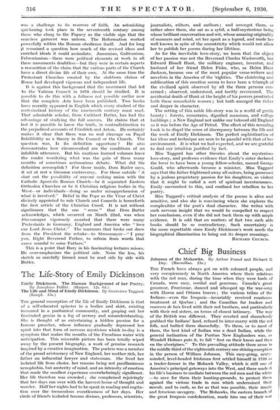The Life-Story of Emily Dickinson
The Life and Mind of Emily Dickinson. By Genevieve Taggard. (Knopf. iSs.)
TIIE general conception of the life of Emily Dickinson is that of a self-educated spinster in a bodice and skirt, existing immured in a puritanical community, and gasping out her frustrated genius in a fog of secrecy and misunderstanding. She is thought of as entertaining a hidden passion for a famous preacher, whose influence gradually depressed her spirit into that form of nervous mysticism which to-day is a symptom that makes the mouths of the Freudians water with anticipation. This miserable picture has been totally wiped away by the present biography, a work of genuine research inspired by a creative imagination. The poetess was a member of the proud aristocracy of New England, her mother rich, her father an influential lawyer and statesman. She lived her isolated life from choice, her reasons being not pusillanimous xenophobia, but austerity of mind, and an intensity of emotion that made the smallest experience overwhelmingly significant. Her life therefore was crowded ; she complained rejoicingly that her days ran over with the harvest-home of thought and wonder. Half her nights had to be spent in reading and cogita- tion over the tremendous eventlessness of her days. Her circle of friends included famous divines, professors, scientists,
journalists, editors, and authors ; and amongst them, or rather above them, she sat as a sybil, a half-mysterious being whose brilliant conversation and.wit, whose amazing originality of manners and mind, set her apart as a legend, and made her well known in spite of the eccentricity which would not allow her to publish her poems during her lifetime.
As for the inevitable love-story, 'we learn that the object of her passion was not the Reverend Charles Wadsworth, but Edward Bissell Hunt, the military engineer, inventor, and husband of her friend Helen Fiske, who, as Helen Hunt Jackson, became one of the most popular verse-writers and novelists in the America of the 'eighties. The cloistering and sublimation of this emotion seems to have been a triumph of the civilized spirit observed by all the three persons con- cerned; observed, understood, and tacitly reverenced. The accidental death of Hunt at the height of his powers prostrated both these remarkable women ; but both emerged the richer and deeper in character.
The setting of this noble life-story was in a world of gentle beauty : forests, mountains, dignified mansions, and college buildings ; a New England not unlike our beloved old England as it was before the Age of Petrol. The effect of this revealing book is to dispel the sense of discrepancy between the life and the work of Emily Dickinson. The perfect sophistication of her ideas and technique are seen to be parallel with that of her environment. It is what we had expected, and we are grateful to find our intuition justified by fact.
Miss Taggard has other theories about the mysterious love-story, and professes evidence that Emily's sister declared the lover to have been a young fellow-scholar, named George Gould, who afterwards became a minister. Miss Taggard says that the father frightened away all suitors, being possessed by a jealous proprietary passion for his daughters, so violent that it might be called a sort of spiritual incestuousness. Emily succumbed to this, and confined her rebellion to her poetry.
Miss Taggard's critical analysis of the poems is alive and sensitive, and also she is convincing where she explores the complexities of the poet's dual character. She writes with such nervous insight that we would be compelled to respect her conclusions, even if she did not back them up with ample evidence. It is odd that on matters of fact two• such able books should be so contradictory. Such uncertainty is the more regrettable since Emily Dickinson's work needs the biographical illumination to bring out its deeper meanings.
RICHARD CHURCH.






























 Previous page
Previous page